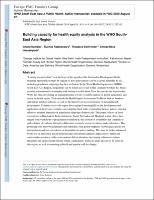| dc.description.abstract | Leaving no one behind” is at the heart of the agenda of the Sustainable Development Goals, requiring that health systems be vigilant to how interventions can be accessed equitably by all, including population subgroups that face exclusion. In the World Health Organization (WHO) South-East Asia Region, inequalities can be found across and within countries but there has been a growing commitment to examining and starting to tackle them. Over the past decade in particular, WHO has been developing an armamentarium of tools to enable analysis of health inequalities and action on health equity. Tools include the Health Equity Assessment Toolkit in built-in database and upload database editions, as well as the Innov8 tool for reorientation of national health programmes. Countries across the region have engaged meaningfully in the development and application of these tools, in many cases aligning them with, or including them as part of, ongoing efforts to examine inequities in population subgroups domestically. This paper reflects on these experiences in Bangladesh, India, Indonesia, Nepal, Sri Lanka and Thailand, where efforts have ranged from workshops to programme reorientation; the creation of assemblies and conferences; and collation of evidence through collaborative research, reviews/synthesis and conferences. This promising start must be maintained and expanded, with greater emphasis on building capacity for interpretation and use of evidence on inequalities in policy-making. This may be further enhanced by the use of innovative mixed methodologies and interdisciplinary approaches to refine and contextualize evidence, with a concomitant shift in attention, developing solutions to redress inequities and anchor health reform within communities. There are many lessons to be learnt in this region, as well as mounting political and popular will for change. | |

